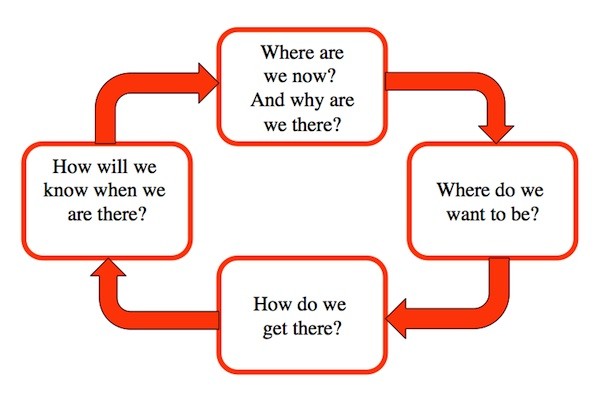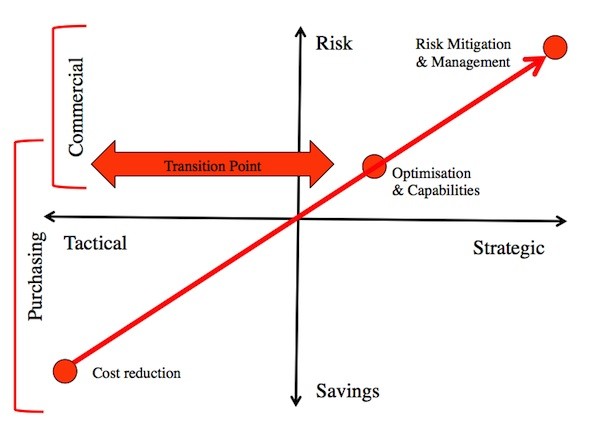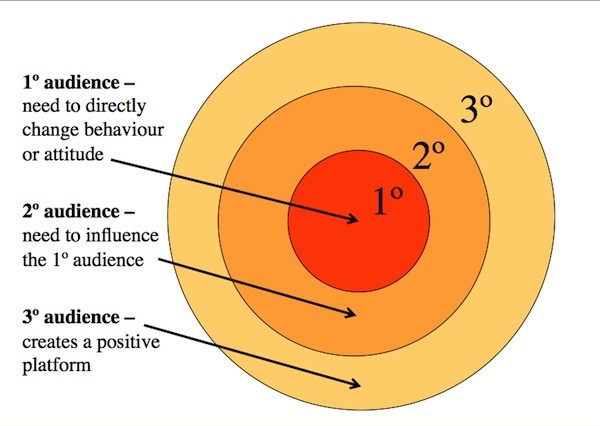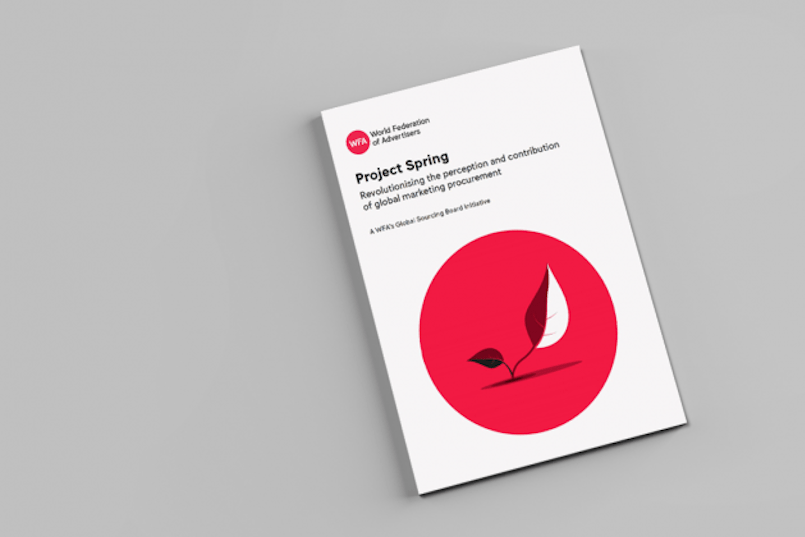I was invited to facilitate three dialogues as part of the CIPSA CPO Agenda 100 Forum held at the Novotel, Brighton Beach in Sydney. Over two days we held three 90 minute discussions on the topic “How to rebrand Procurement”.
The sessions were attended by some of the top CPOs in Australia and New Zealand, with vigorous and robust discussions on the topic. This post provides you with a summary of these discussions, from the perspective of the CPOs who participated.
The process
The discussions were structured around the strategic process below.
The session used a number of tools and processes developed by TrinityP3 to assist in defining the issues and developing solutions to the problems and opportunities identified.
Where are we now and why are we there?
The start of the discussion focused on brand versus positioning. We needed to consider if the problem was the Procurement brand or the positioning of that brand. From this we can decide if Procurement needed re-branding or simply repositioning or both.
The procurement brand is not clearly defined or clearly positioned. The term procurement has a wide range of titles and names, which will vary from company to company and market to market, including:
- Strategic Sourcing
- Purchasing
- Procurement
- Buying
- Supplier Management
We also discussed how procurement was considered or positioned in the market. Again, the perceptions will depend on the organisation, but in most cases are largely functional.
Procurement is…
Transactional, Process, Bureaucracy, Despicable, Inflexible, Cost/Price focus, Blockage, Restrictive, Dodgy Integrity, Tactical, Cost reduction, Process Jockey, Self Serving, Challenging, High commercial acumen and too commercial.
To explore this further we used a brand association process. In this exercise participants provided brands that they associated with Procurement in a range of unrelated categories. The most important thing was the reason why they had this association as this indicates why they had the following perceptions.
| Food / beverage – take away, restaurants, wines, soft drinks, etc |
|
| Entertainment – tv shows, movies, albums, bands, plays, actors, |
|
| Automotive – marques, styles, etc |
|
| Computers / technology – printers, scanners, copiers, computers etc, |
|
| Fashion / cosmetics – designers, accessories, casual and sports wear etc |
|
| Media – newspapers, web sites, magazines, radio stations, tv stations, etc |
|
| Financial services – banks, health funds, superannuation, insurance etc |
|
| Retailer |
|
The theme across the majority of the associations is functional and pragmatic. Procurement fulfils a need, but what is lacking is a consistent value proposition and a powerful reason for being.
Where do we want to be?
In discussing “Where we are now?” CPOs began to project where Procurement could and should be within their organisations.
- Instead of being Blockers they are seen as Business Change Drivers
- Instead of being Tactical they are seen as Strategic Solutions Providers
- Instead of being Cost Cutters they are seen as Value Creators
- Instead of being Transactional they are seen as Independent Commercial Partners
- Instead of being Blockers they are seen as Trusted Business Advisors
Both the Association of National Advertisers in the USA and the WFA with Spire UK have identified a very similar maturation approach to the procurement function within the marketing function of organisations that is described in the diagram below.
This process commences with Procurement typically providing a costs reduction function and over time this evolving to optimising process and developing capabilities within the organisation and ultimately managing risk mitigation. This transition from cost to risk and from tactical to strategic reflect the same transition the CPOs in the dialogues expressed as the transition from where they are perceived now to where they want to be.
The discussion then proceeded into what was required to transition from one to the other. Several participants identified this maturation process was also reflected in some of the names given to the Procurement function. Specifically the move from Buying and Purchasing to Strategic Sourcing and Commercial Management.
The standard maturation process requires Procurement in many organisations to:
- Prove their business case and efficacy with delivering cost reduction and savings
- This opens opportunities to identify and deliver process optimisation and commercial capabilities building
- Ultimately leading to a strategic position within the organisation managing and mitigating risk
Most of the CPOs recognised this transition process. While acknowledging that there is variation across organisations, industry categories and markets, there is some consensus that the Australian and New Zealand market is approaching the ‘Transition Point’ between Purchasing and Commercial Management.
How do we get there?
Of course we could do nothing and hope that the natural maturation process continues. But there was an understanding that this process can be managed, facilitated and expedited. The first step is to undertand the key stakeholders and their role and importance in this process.
|
PRIMARY STAKEHOLDERS |
SECONDARY STAKEHOLDERS |
TERTIARY STAKEHOLDERS |
|
CEO/Executive Team Board End user / Budget Holders Procurement Team Finance |
Suppliers Statutory Bodies Government Regulators Procurement Team
|
Universities Customers (Ext) Media Shareholders
|
Each of these stakeholder groups would then be reviewed and a specific communications plan or story developed for that group. In the dialogue sessions we had time to look at a few of the Primary Stakeholder Groups and the story changes required to reposition the Procurement brand.
End Users
- From Cost/Savings benefit to Value/Trusted advisors
- From Time wasters to Business advisor
- From Service provider to Valued Colleague
- From Servitude to Commercial Services
CEO/Board
- From Investment to Insurance
- From Cost reduction to Risk mitigation & Adding Value
- Maturing from Savings to Efficiency to Risk Mitigation
- From having to Justify existence to being a Business Necessity
Procurement team
- From Compliance to Value creators and Solution providers
- From Tactical to Strategic
- From Frustration to Integration
- From Professional homeless to Trusted Advisor
How will we know when we are there?
There is no point developing and implementing a strategy unless you have a way of determining progress and if it is working. The discussion centered around aligning the measures to the objectives. But ultimately the measure was a change in perception and actions that would indicate that Procurement no longer needs to justify its existence, but instead is simply considered a necessary and essential part of business.
We know we are there when:
- The C-suite invites you to the strategy day session
- Invited to participate in all areas of the business
- Essential and necessary at all levels of business
- Procurement is considered an essential stage in career development
- The CPO is a true partner in the C-suite (or runs the C-suite as the CEO)
Conclusion
We must recognise that this was an introductory discussion and that the audience was exclusively those working in the profession at the highest level of CPO. To develop the strategic direction fully would require market research of the stakeholders to determine their current perceptions of the Procurement profession and from this develop and determine the correct strategy.
However there were some interesting and insightful points made during these dialogue sessions that provided a view of the issues and possible solutions. I am providing these simply for discussion and in no way say they are definitive or correct.
- While Procurement has many different names as a brand, it also has many different brand positionings, which would not be solved just by choosing a new name.
- There is no consistent or uniform and recognised entry into the category, with huge diversity in qualifications, professional expertise and focus (the professional homeless?)
- Procurement is inclined to evolve and mature within organisations over time from a tactical functional role to a more strategic and valuable role.
The questions yet to be answered are how to take these findings forward.
- How can Procurement develop and promote a consistent value story for business?
- With so much diversity in titles, roles, responsibilities and functions, is it possible to develop a consistent and meaningful value story?
- What are the roles and functions of the various stakeholder groups including professional industry bodies in coordinating and managing this process?
This is clearly of interest to the Procurement leaders represented in the CPO Forum. The best opportunity is to continue the discussion and collect the inputs from the profession in developing the best way forward.
So what are your thoughts on this? What do you think is the ‘value story’ for Procurement?
Lets continue the conversation here by leaving a comment or point for discussion and consideration.








One thought on “Does procurement need rebranding or repositioning?”
An excellent overview, Darren. As businesses rediscover the need to grow the top line alongside smart cost management this will have to become an area of focus in the next few years.
Comments are closed.